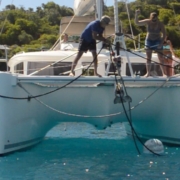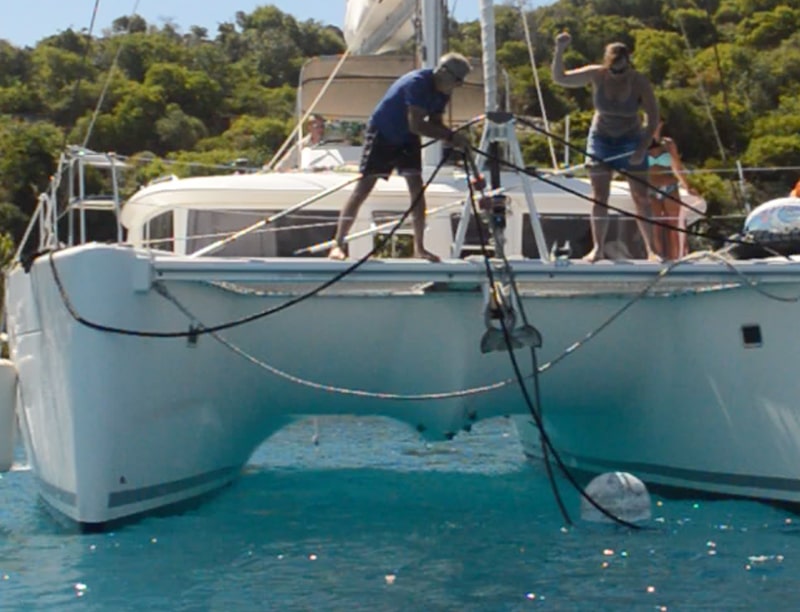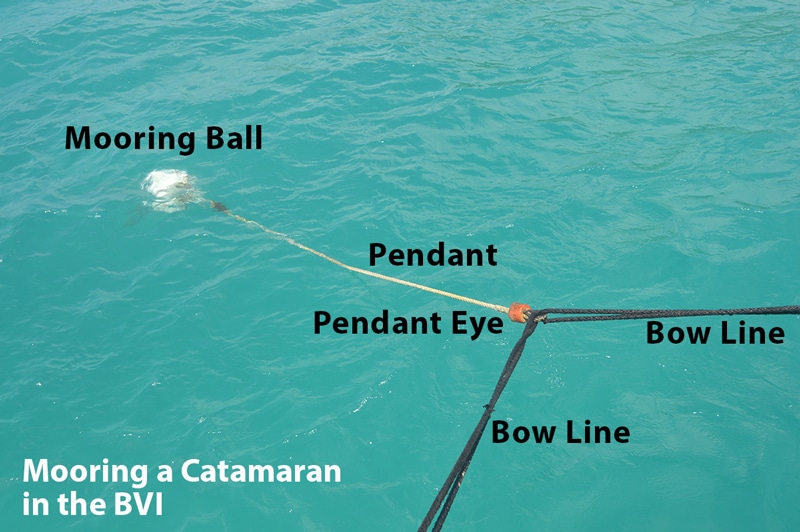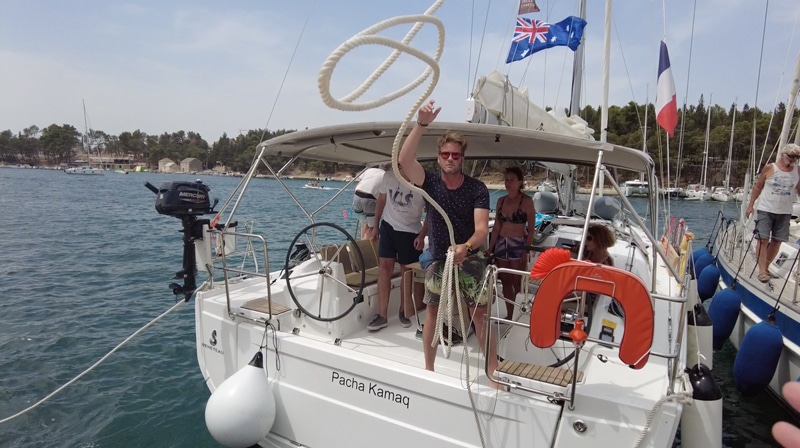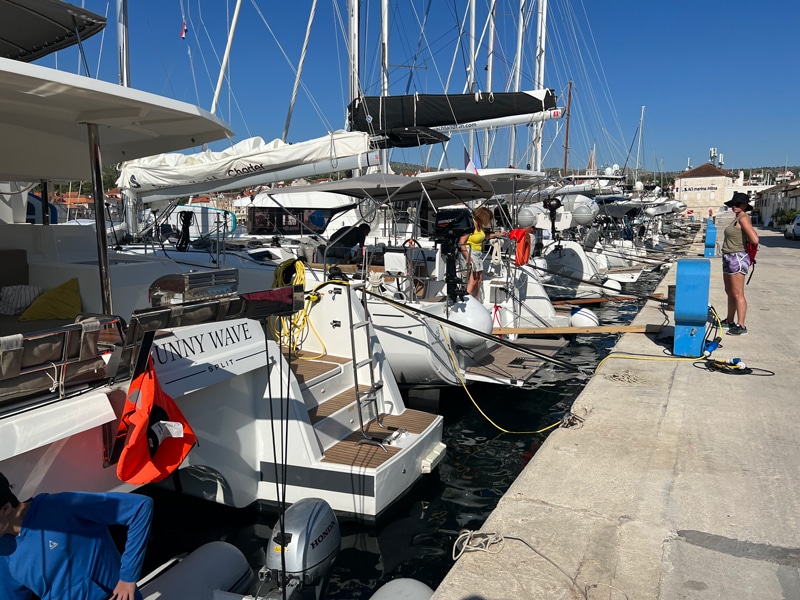Sailboat Mooring Procedures
Mooring
The procedure for tying to a mooring is theoretically very easy. You simply motor up and using a boat hook, grab the float and attach to it to your boat. It sounds simple but you will see many dismal failures when watching others try it.
Success lies in establishing crew assignments: helmsperson, pointer, retriever, lines-person; and in making a proper plan.
Crew assignments: Who is doing what? The pointer and the helmsperson must have a pre-established series of communications using hand signals. This is the most critical because the longer the helmsperson can keep the mooring ball exactly at the bow of the boat, the more time the retriever and lines person have to properly secure the boat. Thus if possible, the pointer should have the job of only being a pointer— to continuously give hand signal instructions to the helmsperson: where the ball is, what direction to move, to slow down, to stop in the water, to disengage gear.
The retriever hooks the mooring pendant and brings it up out of the water onto the bow of the boat.
The lines person prepares the bowlines ahead of time by cleating one end to a bow cleat and making sure the remaining line is untangled and clear to pull through the pendant’s eye. Then, once the pendant is brought on board he or she runs the bowlines through the pendant and back to a bow cleat. When shorthanded, the retriever and the lines person can be the same person. It is best to have the pointer remain as the pointer throughout the entire maneuver. This is because the boat can quickly drift off and thus the helmsperson needs to know at all times how to maneuver the boat to keep the mooring ball at the bow.
The plan, once the crew assignments have been made goes like this:
- Select a mooring ball. Communicate that to the crew.
- Lines-person ready with clear lines? Ready.
- Retriever ready with a boat hook? Ready.
- Pointer ready? Ready.
- As the boat approaches, the pointer essentially takes control of the boat via hand signals back to the helmsperson.
- The retriever and lines person do their jobs to secure the boat as fast as possible. They do not try to get the lengths of everything correct initially. The primary objective is to secure the boat and then make adjustments to the bowlines after the boat is settled.
Notes
There are variances based on the type of mooring ball setup, boat type (monohull or catamaran), and the current flow versus wind strength.
Mooring Ball Setup
Most often the actual mooring line that you bring on board is a floating line attached to the mooring just below the ball. You simply hook the floating line and bring it aboard. When securing to a cleat, make sure it is a thick mooring line, not a thin messenger line. With some mooring balls, you can use the line on the mooring ball to cleat to your deck. With others, you use your own bowlines to run through the pendant or through a ring on the mooring ball.
If you encounter a steel ring in the top of the ball, you loop your own bowline through the ring. The problem with this configuration is that you cannot lift the ball out of the water with the boat hook, nor can you reach down to it from your forward deck. There is another method to get to the mooring ball if it is configured this way. Simply back up the boat to the mooring ball with your aft facing the wind. The lines person has a better chance of reaching the mooring ball in this manner because the aft of the boat is not as high as the bow and the helmsperson and the lines person can work together easier. It is preferable to use a long line that is already attached at one end to a forward cleat and run around the outside of everything (stays, lifelines, and bimini). The lines person then simply walks the free end back to the forward deck, pulling in the slack, and attaches it to the opposite cleat.
For Catamarans
With a catamaran, typically you will run a bowline from one hull to the pendant and back to the same hull. Then repeat for the other hull. This method stabilizes the catamaran from swaying with the wind.
Mooring a Catamaran
Current vs. Wind Strength
Approach the mooring ball from downwind or down-current, whichever has the strongest effect on the vessel.
Safety Notes
- It is easier to go around and do it again than have your crew hurt themselves trying to hold the boat to the ball with the boat hook while the boat drifts away. Train your crew to unhook the boat hook and let the ball go if it becomes difficult to hold.
- The mooring configuration is always subject to weather, corrosion, currents, and rotting lines that erode the mooring integrity. Thus, you should be cognizant of potentially being released during the night and dangerously drifting away. For this reason, similar to anchoring, you should always check your position during the night. Use anchoring apps.
Mediterranean Mooring
A Mediterranean Mooring is different. It is shown below where the boat backs up to a (very hard concrete) dock. The mooring line is picked up at the front of the boat and cleated tightly which holds the boat off from the wall. Successfully performing a “Med” mooring is a skillful operation.
It requires good backing skills, a bit of luck, a good crew, lots of fenders and dock lines ready, the wind behaving itself, and an excellent leader as a captain.
Mediterranean Mooring is covered extensively in the Maneuvering Under Power course which is part of the Skipper Bundle of courses.


